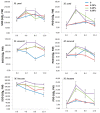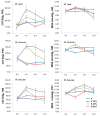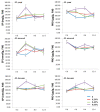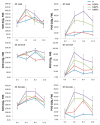Effects of Salt Stress on the Antioxidant Activity and Malondialdehyde, Solution Protein, Proline, and Chlorophyll Contents of Three Malus Species
- PMID: 36431064
- PMCID: PMC9696785
- DOI: 10.3390/life12111929
Effects of Salt Stress on the Antioxidant Activity and Malondialdehyde, Solution Protein, Proline, and Chlorophyll Contents of Three Malus Species
Abstract
Understanding the different physiological responses of Malus species under salt stress in the seedling stages will be useful in breeding salt-tolerant dwarfing apple rootstocks. Seedlings of Malus Zumi (Mats.) Rehd. (M. zumi), Malus sieversii (Led.) Roem. (M. sieversii), and Malus baccata (L.) Borkh. (M. baccata) were treated with solution of 0, 0.20%, 0.40%, and 0.60% salinity. Physiological parameters of their leaves and roots were measured at 0 d, 4 d, 8 d and 12 d after salinity treatments. Superoxide dismutase (SOD), peroxidase (POD), catalase (CAT), malondialdehyde (MDA), solution protein (SP), and proline (PRO) initially increased and then decreased. The activities and contents of these parameters were higher in the 0.40% and 0.60% NaCl treatments than in the 0.20% treatment and in the 0% control. M. zumi was the most resistant to salt stress, showing the lowest content of MDA in the leaves and roots, which increased slightly under salt stress. M. baccata had the highest increase in both the content and proportion of MDA. High enzyme activity was shown to play an important role in the salt resistance of M. zumi. Moreover, it can be speculated that there are other substances that also play a major role. We found that osmotic regulation played a key role in response to salt stress for M. baccata even though it was sensitive to salt stress. For M. sieversii, both the osmotic regulation and enzymatic antioxidants were observed to play a major role in mitigating salt stress.
Keywords: Malus seedlings; NaCl treatments; enzyme activity; membrane damage; osmotic regulation.
Conflict of interest statement
The authors declare no conflict of interest.
Figures








References
-
- FAO . Status of the World’s Soil Resources (SWSR)–Main Report. Volume 650 FAO; Rome, Italy: 2015. Food and Agriculture Organization of the United Nations and Intergovernmental Technical Panel on Soils.
-
- Jamil A., Riaz S., Ashraf M., Foolad M.R. Gene expression profiling of plants under salt stress. Crit. Rev. Plant Sci. 2011;30:435–458. doi: 10.1080/07352689.2011.605739. - DOI
-
- Alasvandyari F., Mahdavi B., Hosseini M.S. Glycine betaine affects the antioxidant system and ion accumulation and reduces salinity-induced damage in safflower seedlings. Arch. Biol. Sci. 2017;69:139–147. doi: 10.2298/ABS160216089A. - DOI
Grants and funding
LinkOut - more resources
Full Text Sources
Miscellaneous

